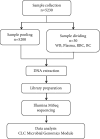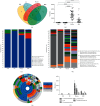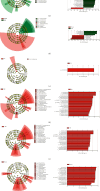Bacterial Analysis of the Whole Blood in Chinese Healthy Donors Using 16S rDNA-Targeted Metagenomic Sequencing
- PMID: 39444936
- PMCID: PMC11498981
- DOI: 10.1155/2024/6635560
Bacterial Analysis of the Whole Blood in Chinese Healthy Donors Using 16S rDNA-Targeted Metagenomic Sequencing
Abstract
Background: The presence of bacteria in the blood of healthy individuals remains controversial. This study explored the comprehensive bacterial profiles and specific biomarkers in different components of healthy Chinese blood donors. Methods: A total of 5230 whole blood (WB) specimens were collected. Among them, 5200 random samples were pooled into 26 mixed samples for bacterial profile analysis. The remaining 30 random samples were divided into 4 groups based on components: WB, plasma, red blood cells (RBCs), and buffy coat (BC). Subsequently, the amplicons of the bacterial 16S rDNA V3-V4 fragments were sequenced to measure the diversity and composition of the bacteria using next-generation sequencing. Results: The bacterial DNAs in the blood primarily originated from the Proteobacteria phylum. A total of 301 species of bacterial DNA were found in blood specimens, with 46 species being present among all groups. A significantly higher abundance of bacterial DNA was found in the plasma and RBCs compared to those in BC and WB. However, the plasma and RBC groups showed significantly higher species diversity and richness compared to the BC and WB groups. In addition, the WB group had a significantly different community structure and composition compared to the plasma and RBC groups but was similar to the BC group. Conclusion: The presence of bacterial DNA fragments was confirmed in blood from healthy Chinese donors. The bacterial DNA fragments enriched in plasma showed the highest diversity, followed by RBC, WB, and BC. These results provide a foundation for further research on the microbiome in the blood of healthy individuals.
Keywords: 16S rDNA; Chinese blood donors; blood components; blood microbiome; whole blood.
Copyright © 2024 Jingjing Zhang et al.
Conflict of interest statement
The authors declare no conflicts of interest.
Figures







Similar articles
-
Comprehensive description of blood microbiome from healthy donors assessed by 16S targeted metagenomic sequencing.Transfusion. 2016 May;56(5):1138-47. doi: 10.1111/trf.13477. Epub 2016 Feb 10. Transfusion. 2016. PMID: 26865079
-
Growth and Distribution of Bacteria in Contaminated Whole Blood and Derived Blood Components.Transfus Med Hemother. 2024 Feb 21;51(2):76-83. doi: 10.1159/000536242. eCollection 2024 Apr. Transfus Med Hemother. 2024. PMID: 38584696 Free PMC article.
-
Characterization of blood components separated from donated whole blood after an overnight holding at room temperature with the buffy coat method.Transfusion. 2011 Oct;51(10):2199-207. doi: 10.1111/j.1537-2995.2011.03137.x. Epub 2011 Apr 14. Transfusion. 2011. PMID: 21492181
-
Hepatic microbiome in healthy lean and obese humans.JHEP Rep. 2021 Apr 27;3(4):100299. doi: 10.1016/j.jhepr.2021.100299. eCollection 2021 Aug. JHEP Rep. 2021. PMID: 34169247 Free PMC article.
-
Whole blood treated with riboflavin and ultraviolet light: quality assessment of all blood components produced by the buffy coat method.Transfusion. 2015 Apr;55(4):815-23. doi: 10.1111/trf.12895. Epub 2014 Oct 29. Transfusion. 2015. PMID: 25355434
Cited by
-
The Microbiome and Metabolic Dysfunction-Associated Steatotic Liver Disease.Int J Mol Sci. 2025 Mar 22;26(7):2882. doi: 10.3390/ijms26072882. Int J Mol Sci. 2025. PMID: 40243472 Free PMC article. Review.
References
LinkOut - more resources
Full Text Sources

